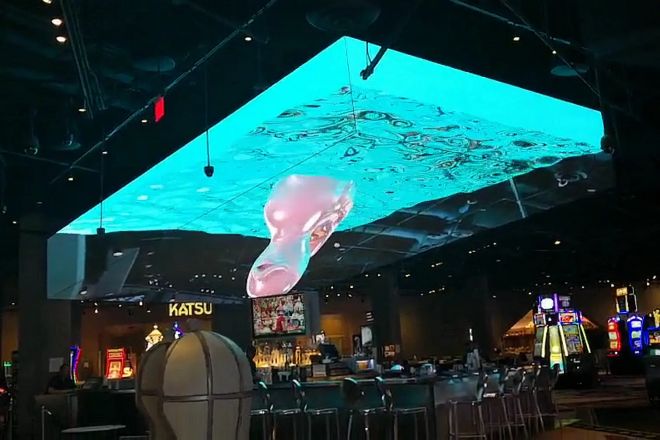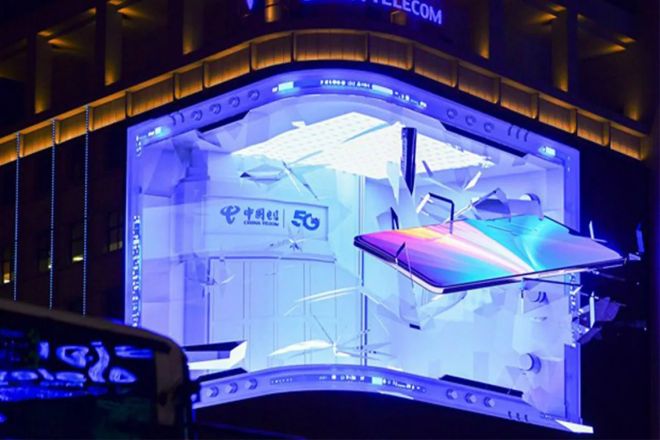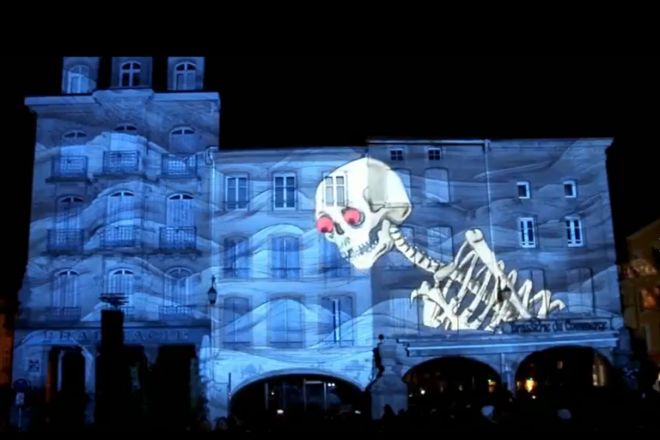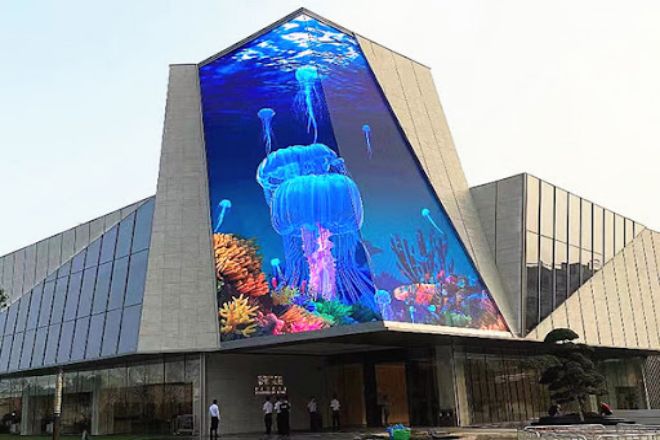Introducción

Con el rápido desarrollo de la ciencia y la tecnología, la tecnología de experiencia visual está rompiendo constantemente los límites tradicionales y brindándonos un festín sensorial sin precedentes. Pantallas de visualización LED 3D brillan en publicidad, exposiciones, representaciones teatrales y otros campos con su excelente rendimiento, como alta definición, alto brillo y alto contraste.
La tecnología de proyección holográfica, con su exclusivo método de imagen e interactividad, hace que el público se sienta como si estuviera en un mundo virtual lleno de fantasía y sorpresa. Cuando estas dos tecnologías se integran y se vinculan entre sí, ¿qué tipo de experiencia visual impactante se producirá?
1. Descripción general de la tecnología de visualización LED 3D

Una pantalla LED 3D es una pantalla hecha de perlas de lámpara LED, que tiene la capacidad de mostrar imágenes tridimensionales. Por lo general, está compuesta por muchas perlas de lámpara LED pequeñas que pueden emitir luz en diferentes colores y brillos, creando efectos tridimensionales realistas a través de programación y control.
1) Las características incluyen:
Alto brillo: los LED tienen un alto brillo y se pueden utilizar en entornos brillantes.
Colores brillantes: el LED tiene una alta reproducción de color y puede mostrar colores más vivos y realistas.
Alto contraste: el LED tiene un alto contraste y puede mostrar imágenes más claras.
Larga vida útil: el LED tiene una larga vida útil, que puede alcanzar decenas de miles de horas.
Ahorro de energía y protección del medio ambiente: el LED tiene un bajo consumo de energía, lo que está en línea con el concepto de protección del medio ambiente y ahorro de energía.
2) Calidad de pantalla, resolución y reproducción del color.
Calidad de visualización: La pantalla LED 3D logra un efecto de visualización de alta calidad mediante una disposición fina de las perlas de la lámpara LED y una tecnología de control avanzada. Su alta definición y su imagen delicada permiten que el público disfrute de una experiencia visual más realista.
Resolución: La pantalla LED 3D admite una visualización de alta resolución, que puede presentar imágenes más claras y delicadas. Esto permite mostrar contenido visual más delicado y complejo en publicidad, exposiciones y otros campos.
Reproducción de color: la pantalla LED 3D tiene un excelente efecto de reproducción de color y puede restaurar con precisión el color de la imagen original. Esto permite mostrar productos, obras de arte y otros elementos manteniendo su color y textura reales.
3) Caso de aplicación
- Campo publicitario:
En la publicidad comercial, las pantallas LED 3D se utilizan ampliamente en lugares como centros comerciales, exposiciones y vallas publicitarias al aire libre. Mostrar contenido publicitario tridimensional vívido y realista atrae la atención de los clientes y mejora la imagen de marca y las ventas.
Por ejemplo, el proyecto de pantalla 3D especial a simple vista de la ciudad de Qingdao Jinmao Lanxiu crea una experiencia comercial inmersiva para esta ciudad a través de tecnología de pantalla LED profesional y contenido creativo.
- Campo de entretenimiento:
En actividades de entretenimiento como presentaciones en escenarios y conciertos, las pantallas LED 3D se pueden utilizar como fondos o accesorios para brindar una experiencia visual más impactante e inmersiva a la audiencia.
Por ejemplo, en el plan de renovación del Hotel SLS de Las Vegas se aplicaron nuevas tecnologías de medios como “3D a simple vista”, “holográfico” y “Mapping” para proporcionar a los clientes del hotel un disfrute visual único.
- Ámbito de exposición:
En museos, exposiciones de arte y exposiciones de ciencia y tecnología, las pantallas LED 3D pueden mostrar exposiciones más vívidas y fascinantes. Al mostrar modelos tridimensionales, animaciones y otros contenidos, el público puede comprender mejor las historias y los principios detrás de las exhibiciones.
Por ejemplo, el proyecto de pantalla 3D a simple vista en Luoyang, Henan, presenta la historia y la cultura de las Grutas de Longmen al público de una manera nueva a través de tecnologías de visualización óptica como la tecnología 3D a simple vista y XR.
2. Descripción general de la tecnología de proyección holográfica

La tecnología de proyección holográfica, también conocida como tecnología de imágenes virtuales, es una tecnología que utiliza los principios de interferencia y difracción para registrar y reproducir la imagen tridimensional real de un objeto.
Su principio básico es iluminar el objeto con un haz de luz (luz del objeto) y superponer la luz reflejada (o luz transmitida) del objeto con otro haz de luz de referencia (normalmente una onda plana) sobre el medio de grabación para producir un patrón de interferencia, es decir, un holograma.
Cuando el holograma se ilumina con una luz adecuada y coherente, la imagen tridimensional del objeto original se puede reproducir mediante el efecto de difracción.
1) Características de la imagen, efectos visuales e interactividad.
- Características de la imagen:
La tecnología de proyección holográfica puede capturar y reproducir la información de amplitud y fase del objeto, por lo que la imagen generada tiene una sensación tridimensional real. En comparación con la tecnología de proyección bidimensional tradicional, la imagen de la proyección holográfica es más vívida y realista.
- Efectos visuales:
La tecnología de proyección holográfica puede presentar imágenes con una sensación de profundidad y espacio, y el público puede ver la imagen estereoscópica tridimensional a simple vista sin usar ningún equipo auxiliar. Además, la proyección holográfica también tiene las características de alta definición y alta reproducción de color, lo que puede proporcionar una experiencia visual de alta calidad.
- Interactividad:
La tecnología de proyección holográfica es altamente interactiva. Al combinar tecnologías como pantallas táctiles, captura de movimiento corporal por infrarrojos y control de sonido, el público puede interactuar con imágenes virtuales en tiempo real y obtener una experiencia más rica. Esta interactividad no solo mejora la sensación de participación del público, sino que también mejora la eficiencia y la precisión de la transmisión de información.
2) Casos de aplicación
- Realidad virtual (RV):
La tecnología de proyección holográfica tiene amplias posibilidades de aplicación en el campo de la realidad virtual. Mediante la construcción de un sistema de proyección holográfica, se puede proporcionar a los usuarios una experiencia de realidad virtual inmersiva. Por ejemplo, en el campo de los juegos, la tecnología de proyección holográfica puede crear escenas y personajes de juego realistas y mejorar la diversión y el atractivo de los juegos.
- Realidad aumentada (RA):
En el campo de la realidad aumentada, la tecnología de proyección holográfica puede combinar imágenes virtuales con entornos reales para proporcionar a los usuarios métodos de interacción y visualización de información más completos.
Por ejemplo, en el sistema de guía, la tecnología de proyección holográfica puede mostrar modelos de reconstrucción virtual de reliquias históricas, lo que permite a los usuarios comprender la cultura histórica de forma más intuitiva.
- Puesta en escena:
La aplicación de la tecnología de proyección holográfica en el campo de las representaciones teatrales ha alcanzado una madurez considerable. Mediante la tecnología de proyección holográfica, se puede crear un efecto escénico fantástico, brindando un espectáculo audiovisual impactante al público.
Por ejemplo, en los conciertos, la tecnología de proyección holográfica se puede combinar con música para presentar efectos visuales coloridos; en representaciones teatrales, la tecnología de proyección holográfica puede ayudar a los actores en sus actuaciones y mejorar el atractivo de la trama.
Con el avance continuo de la tecnología y la expansión de los campos de aplicación, la tecnología de proyección holográfica jugará un papel más importante en el futuro.
3. El potencial de conexión de la pantalla LED 3D y la proyección holográfica
1) Análisis de complementariedad
- Efecto visual:
Las pantallas LED 3D brindan imágenes claras y realistas a la audiencia con su alta resolución, alta reproducción de color y excelente rendimiento de brillo. La tecnología de proyección holográfica brinda a la audiencia una experiencia visual inmersiva al reproducir la sensación tridimensional de los objetos.
La combinación de ambos puede producir efectos visuales más ricos y tridimensionales, haciendo que el público se sienta como si estuviera en un mundo real y de ensueño.
- Interactividad:
La tecnología de proyección holográfica es altamente interactiva y puede interactuar con la audiencia en tiempo real. Las pantallas LED 3D pueden interactuar con la audiencia a través de tecnologías como las pantallas táctiles.
El vínculo entre ambos puede ampliar aún más la forma de interacción, permitiendo a la audiencia participar más profundamente en el contenido mostrado y obtener una experiencia más rica.
- Innovación:
La combinación de las pantallas LED 3D y la proyección holográfica puede romper las limitaciones de los métodos de visualización tradicionales y crear una nueva forma de visualización. Este innovador método de visualización no solo puede atraer la atención del público, sino que también estimula su imaginación y creatividad, lo que le permite disfrutar de una experiencia sin precedentes.
2) Dificultades técnicas y soluciones
- Integración técnica:
Integrar de manera efectiva la tecnología de proyección holográfica y la pantalla LED 3D es un desafío técnico. Es necesario resolver las diferencias entre ambas en cuanto a principios de imagen, métodos de visualización, sistemas de control, etc. para lograr una conexión perfecta. Las soluciones incluyen el desarrollo de software de control general, la optimización de algoritmos de visualización, etc.
- Sincronicidad:
Para garantizar la suavidad y precisión del efecto de vinculación, es necesario asegurar la sincronización de la pantalla LED 3D y la proyección holográfica en contenido, ritmo, acción, etc. Esto requiere tecnología de control de sincronización precisa y tecnología de transmisión de datos.
- Compatibilidad de hardware:
Pueden existir problemas de compatibilidad entre las pantallas LED 3D y los equipos de proyección holográfica de diferentes marcas y modelos. Es necesario formular estándares de interfaz y protocolos de comunicación unificados para garantizar la interconexión entre dispositivos.
3) Análisis de potencial
- Mejorar la experiencia de la audiencia:
La conexión entre las pantallas LED 3D y la proyección holográfica puede brindar una experiencia visual más impactante y realista al público, que puede sumergirse en el contenido tridimensional y vívido de la pantalla y obtener una sensación y comprensión más profundas.
- Ampliar escenarios de aplicación:
El ámbito de aplicación de la tecnología de enlace es amplio y abarca múltiples campos, como la publicidad, las exposiciones, las representaciones teatrales, la educación y la formación. Mediante métodos de exhibición innovadores, se puede atraer a más público y participantes, y se puede mejorar el atractivo y la influencia del evento.
- Promover el desarrollo tecnológico:
El desarrollo de la investigación y la aplicación de la tecnología de vinculación promoverán un mayor desarrollo de las pantallas LED 3D y la tecnología de proyección holográfica.
Con el continuo avance e innovación de la tecnología, la experiencia visual del futuro será más colorida y real. Al mismo tiempo, la aplicación de la tecnología de enlace también impulsará el desarrollo y la modernización de las industrias relacionadas e inyectará un nuevo impulso al desarrollo económico y social.
4. Desafíos técnicos y perspectivas futuras

1) Desafíos y limitaciones técnicas actuales
- Integración técnica y sincronización:
Existen diferencias entre las pantallas LED 3D y las tecnologías de proyección holográfica en cuanto a principios de generación de imágenes y métodos de visualización.
Para lograr una vinculación eficaz entre ambos, es necesario resolver el problema de la integración técnica y la sincronización, lo que implica cuestiones como la compatibilidad de los equipos de hardware, la sinergia de los sistemas de software y la naturaleza en tiempo real de la transmisión de datos.
- Alto costo:
Los costos de investigación y desarrollo, fabricación y mantenimiento de la tecnología de proyección holográfica son altos, y los requisitos para los equipos también son relativamente estrictos, lo que limita su popularidad en aplicaciones comerciales.
La vinculación con pantallas LED 3D incrementará aún más los costos, lo que supone un desafío para escenarios con presupuestos limitados.
- Adaptabilidad ambiental:
La tecnología de proyección holográfica tiene altos requisitos ambientales y factores como la luz y el ruido de fondo pueden afectar la claridad y la estabilidad del efecto de proyección.
En entornos exteriores o con mucha luz, el efecto de la proyección holográfica puede verse afectado hasta cierto punto.
2) Medios para superar los desafíos
- Innovación tecnológica:
A través de la innovación tecnológica continua, mejorar el rendimiento y la estabilidad de las pantallas LED 3D y la tecnología de proyección holográfica, reducir costos y mejorar la adaptabilidad ambiental.
Por ejemplo, desarrollar materiales de proyección más eficientes, optimizar los algoritmos de proyección y mejorar la compatibilidad y confiabilidad de los equipos de hardware.
- Apoyo político:
El gobierno puede apoyar la investigación, el desarrollo y la aplicación de pantallas LED 3D y tecnología de proyección holográfica mediante la formulación de políticas pertinentes.
Por ejemplo, proporcionar apoyo financiero, incentivos fiscales, capacitación de talentos y otras medidas de apoyo para alentar a las empresas a aumentar la inversión en I+D y promover la innovación tecnológica y la modernización industrial.
- Cooperación transfronteriza:
Fortalecer la cooperación y los intercambios con otros campos para promover conjuntamente el desarrollo de pantallas LED 3D y tecnología de proyección holográfica. Por ejemplo, cooperar con la producción de cine y televisión, el desarrollo de juegos, la creatividad publicitaria y otros campos para explorar conjuntamente nuevos escenarios de aplicación y modelos comerciales.
3) Tendencias de desarrollo futuras y perspectivas de aplicación
- Integración tecnológica e innovación:
Con el continuo avance e innovación de la tecnología, la integración de las pantallas LED 3D y la tecnología de proyección holográfica será más estrecha, presentando escenarios de aplicación más diversificados y personalizados. Por ejemplo, en el campo del entretenimiento, se pueden lograr personajes virtuales y reproducciones de escenas más realistas.
En el campo de la educación, se puede crear un entorno de aprendizaje inmersivo para mejorar los efectos del aprendizaje; en el campo médico, se puede utilizar para la navegación quirúrgica, visualización de enfermedades, etc.
- Reducción de costes y popularización:
Con la madurez de la tecnología y la intensificación de la competencia en el mercado, el costo de las pantallas LED 3D y la tecnología de proyección holográfica disminuirá gradualmente, lo que las hará más populares y cercanas a la gente. Esto promoverá aún más su aplicación en publicidad comercial, exposiciones, representaciones teatrales y otros campos.
- Adaptabilidad e inteligencia ambiental:
La futura tecnología de proyección holográfica y de pantallas LED 3D prestará más atención a la adaptabilidad ambiental y al desarrollo inteligente. Por ejemplo, al adoptar materiales y algoritmos de proyección más avanzados, se puede mejorar la estabilidad y la claridad de los efectos de proyección en diferentes entornos; al introducir tecnología de inteligencia artificial, se pueden lograr métodos de creación y visualización de contenido más inteligentes, etc.
Conclusión
A través de un análisis en profundidad de la tecnología de vinculación de la pantalla LED 3D y la proyección holográfica, no es difícil descubrir que la combinación de estas dos tecnologías no solo nos brinda un festín visual sin precedentes, sino que también abre un nuevo camino de desarrollo para la futura experiencia visual.
Aunque todavía existen algunos desafíos y limitaciones técnicas, con el continuo avance y la innovación de la tecnología, tenemos razones para creer que la futura experiencia visual será más colorida y real.
Finalmente, si quieres saber más sobre las pantallas LED, Por favor póngase en contacto con nosotros.
